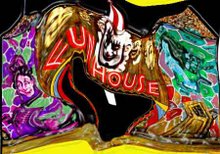Ancient Corinth
So we took off early and headed toward ancient Corinth. Its location on the isthmus between mainland Greece to the Peloponnese made it a cruicial location for transport of goods (and of course also therefore impoortant in martial terms).
Our travels have been dominated by the view of this fortress up above in Acrocorinth.
It was one of the three "Fetters" of Greece - three fortresses that the Athenians used to secure control during Hellenistic period (323-31 BC/E).
Apologies for the window glare on this shot, but I thought this was an interesting wall that we passed on the way to ancient Corith.
The site is quite large, as you can see in this picture below.
It is ruled over by the acropolis above that was later held by the Franks, the Venetians and the Ottomans.
In the fifth century (BC/E) there was a very large theater here that could seat 17,000 people.
The entrance gave us signs with a cursory overview of the site, but there is so much more history and myth that it will not fit into a blog post.
We took our obligatory group photo and then Fearless Leader gave us a few details about the site.
I think even this local learned something new. He certainly seemed very interested.
There wasn't really much signage, so I can't identify the various buildings here.
Suffice it to say that the ruins stretch across a large area and are extremely interesting to look at.
In the back you can see the big grooved road or dilokos (called the Lechaion Road) that allowed for wares to be brought across the isthmus. During the Pelopennesian wars these tracks with carved ruts in them were used to transport triremes (ancient Greek naval vessels) from one sea to the other.
One of the most spectacular sights here is the Doric Temple of Apollo. Mythology has it that both Poseidon and Apollo wanted this city, so Poseidon got the lower part near the sea and Appollo the Acropolis. The city is thus devoted to two gods.
The columns above are particularly interesting since they are monoliths, rahter than columns made of stacked drum pieces. Seven of the 38 columns remain in place with 15 columns per side and 6 per faccade. None of the arithmetic on this makes sense to me - but that is what is reported about the site.
Below you can see an arch at the Agora or market place.
Corinth seems to have been an instigator of both the Pelopennesian wars with Athens, and aligned themselves with Sparta.
It seems like they lost a lot of the wars they were involved in, but being a crucial crossroads for travel they persisted.
Here is the temple of Apollo seen from the Agora.
The mythology of Corinth is rich, even though it was not originally a Mycenean setlement and thus its stories are not rooted in ancient Greek myths. Nonetheless there are Greek origin tales that the city was founded by a descendant of the sun god Helios, and/or that it was grounded by King Sisyphus (of rolling the boulder up the hill fame) and there are many mentions of later Corinth in various ancient texts.
Sisyphus's granson was Bellerephon, who tamed the winged horse Pegasus - and for this reason Corinth has a special relationship with this horse and used the winged horse on many of its ancient coins.
Being a sea port, Corinth was famous for its Hetaira or temple prostitutes serving the Temple of Aphrodite. These women purportedly charged outlandish fees causing the famous poet Horace to proclaim, "non licet omnibus adire Corinthum" (Not everyone can (afford to) go to Corinth.) No doubt this reputation is a reason that Paul decided to come there and preach in 49 or 50 AD/CE.
Here is the capital of one of those famous "Corinthian" columns.
There is a stone structure called the Bema from the top of which Paul held speeches to the Corinthians.
Here is a view from the top.
This is part of the site near Pirene's fountain.
Pausanias reported in the second century, "On leaving the market-place along the road to Lechaeum you come to a gateway, on which are two gilded chariots, one carrying Phaethon the son of Helius, the other Helius himself. A little farther away from the gateway, on the right as you go in, is a bronze Herakles.
After this is the entrance to the water of Peirene. The legend about
Peirene is that she was a woman who became a spring because of her tears
shed in lamentation for her son Cenchrias, who was unintentionally
killed by Artemis. The spring is ornamented with white marble, and there have been made
chambers like caves, out of which the water flows into an open-air well.
It is pleasant to drink, and they say that the Corinthian bronze,
when red-hot, is tempered by this water, since bronze the Corinthians
have not. Moreover near Peirene are an image and a sacred enclosure of Apollo".
Pegasus supposedly liked to come and drink from this spring.
A different myth says that this fountain was created by the hoof of Pegasus striking the ground.
I leave you with various other images of the site.
I am fascinated by the ornament. Below you see a man in a boat.
You can see him better in this shot.
I wish we had had more time to really dig into the history and understand what each of these buildings and ruins was.
But alas there were other fish to fry and other sites to visit on that very day, so we were off up the stairs and racing to the bus again to prepare for the next big adventure!
















































No comments:
Post a Comment